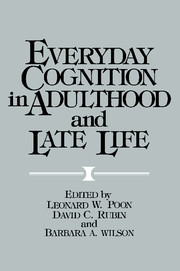Book contents
- Frontmatter
- Contents
- List of contributors
- Preface
- Part I Adult cognitive abilities in the laboratory and in real-life settings: Basic theoretical and methodological issues
- Part IA Systematic approaches to laboratory and real-world research
- Part IB Combining laboratory and real-world research
- Part II Cognition in adulthood and late life: Findings in real-life settings
- Part IIA Everyday cognitive abilities
- Part IIB Concomitant influences
- Part III Cognitive enhancement and aging: Clinical and educational applications
- Part IIIA Issues and perspectives
- Part IIIB Enhancement approaches
- Part IIIC Designing programs for cognitive rehabilitation
- 32 Designing memory-therapy programs
- 33 Management of memory problems in a hospital setting
- 34 Home-based cognitive rehabilitation with the elderly
- 35 Memory retraining: Everyday needs and future prospects
- Subject index
- Author index
35 - Memory retraining: Everyday needs and future prospects
Published online by Cambridge University Press: 05 October 2013
- Frontmatter
- Contents
- List of contributors
- Preface
- Part I Adult cognitive abilities in the laboratory and in real-life settings: Basic theoretical and methodological issues
- Part IA Systematic approaches to laboratory and real-world research
- Part IB Combining laboratory and real-world research
- Part II Cognition in adulthood and late life: Findings in real-life settings
- Part IIA Everyday cognitive abilities
- Part IIB Concomitant influences
- Part III Cognitive enhancement and aging: Clinical and educational applications
- Part IIIA Issues and perspectives
- Part IIIB Enhancement approaches
- Part IIIC Designing programs for cognitive rehabilitation
- 32 Designing memory-therapy programs
- 33 Management of memory problems in a hospital setting
- 34 Home-based cognitive rehabilitation with the elderly
- 35 Memory retraining: Everyday needs and future prospects
- Subject index
- Author index
Summary
Several themes appear and reappear in the work presented in this Part III: (1) the question of the types and characteristics of elderly subjects, (2) theoretical process questions, and (3) an emphasis on practical everyday memory.
Three themes
1. Types and characteristics of elderly subjects. Yesavage, Lapp, and Sheikh (Chapter 31, this volume) suggest that the elderly perform poorly when using visual imagery and often are anxious when using new techniques in testing situations. These authors emphasize the roles of affect, depression, mood-specific effects, and medications in learning and memory processes. Barbara Wilson (Chapter 32, this volume) emphasizes the selection of appropriate strategies for use by particular individuals. Nadina Lincoln (Chapter 33, this volume) discusses these problems as they appear in the general hospital setting. Nick Moffat (Chapter 34, this volume) discusses them at home, where cognitive rehabilitation interacts with the unmet needs of relatives caring for the confused elderly. Apparently it is sometimes necessary to supply external aids for such people. There is growing emphasis on the potential usefulness of well-designed external aids.
I am reminded of a man who suffered from senile dementia of the Alzheimer's type. His daughter-in-law noticed him pushing a silent vacuum cleaner back and forth on a rug. “No, Bill,” she said, as she plugged the vacuum cleaner in, so that it started working. How did he interpret her saying “No”? His immediate response, anyway, was to unplug the cord and resume pushing the vacuum cleaner back and forth.
- Type
- Chapter
- Information
- Everyday Cognition in Adulthood and Late Life , pp. 681 - 691Publisher: Cambridge University PressPrint publication year: 1989
- 4
- Cited by



